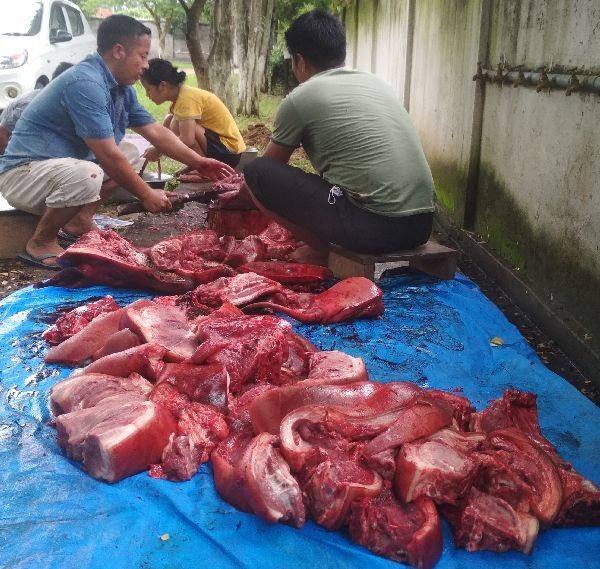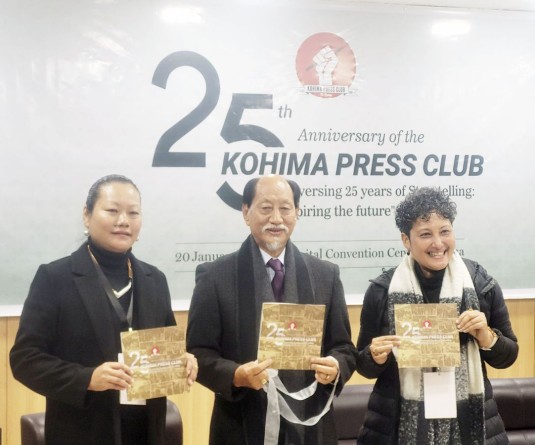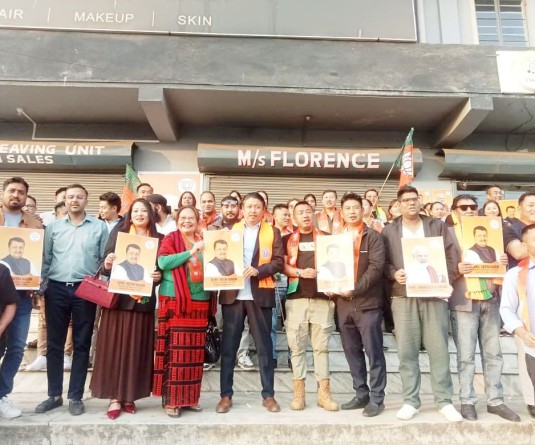Representative Image: Youths engaged in dressing local pork in a locality in Dimapur. Demand for local pork has shot up in Nagaland after the ban on import of pigs from outside the state since April 29. (Morung Photo)

Ashikho Pfuzhe
Dimapur | June 13
A popular meme which circulated on WhatsApp of a man shouting in Nagamese "Colony manu kaunba pera hoilebe Gahori katibi ho...!!" (Anyone from the colony, please slaughter a pig), succinctly conveys the meat-starved scenario in Nagaland.
Three months into the lockdown and meat, once a regular menu on the Naga kitchen table, has become not only rarer but dearer in terms of cost too.
With the state's borders sealed due to the Corona virus pandemic, import of livestock, especially pigs, has come to a standstill leaving many gregarious non-vegetarians grinding their canine teeth in sheer exasperation.
The total animal livestock production in the state falls way too short in meeting the demand of the population and with the ban on import; prices of meat sourced from local livestock have shot up.
However, for those who cannot eat meals without a piece of meat in their plates, price is relegated to the background as they continue to scout the neighborhoods and villages for meat and livestock – physically, by word of mouth or through phones and WhatsApp.
Interestingly, the use of weighing scale has been replaced by ‘bhaag’ or apportioning a whole livestock by piece or part and not by the conventional weight measure. Not an uncommon practice here, however, it has become more or less a norm in a time of scarcity.
It involves a group of individuals pooling money and buying a live pig or cow. After slaughtering it, the meat is divided with each investor getting an equal share of parts.
But the 'share' method is not without its downside. Some butchers are reportedly making higher margin of profit through this method as they circumvent the price per kilo of meat fixed by the municipal or village bodies.
"Last week, I bought beef at the rate of Rs 1,000 per share. When I weighed the meat at home, it was around 3 kilos only. That means I paid more than Rs 300 per kilo", a retired government servant said.
The going rate of local pork also ranges between Rs 300-350 per kilo, whether through shares or weighing scale.
“If we are to make some profit, we have to hike the price as even the pig owners charge more for live pigs these days,” a local butcher said.
The rate of home reared poultry birds like broiler and kuroiler chickens have also gone up.
"Two weeks back, I bought a large kuroiler at the rate of Rs 300 per kg. Though the price was a bit steep, I had to buy as our eldest son passed his matric exam," said a mother of three children.
According to government sources, during 2018-19, the state imported meat worth Rs 121.56 crore (7.279 tonne). However, the shortage of meat in the state stood at 34.66 tonne.
It is estimated that the on an average, the daily consumption of pork in the state is approximately 64,624 kgs with Dimapur district leading the list with 13,448 kgs per day followed by Kohima district with 9,500 kgs.
“With the huge amount of money being drained away due to import of meat, the state government should give equal focus to the animal husbandry sector post COVID-19 pandemic,” a pig farmer said.





